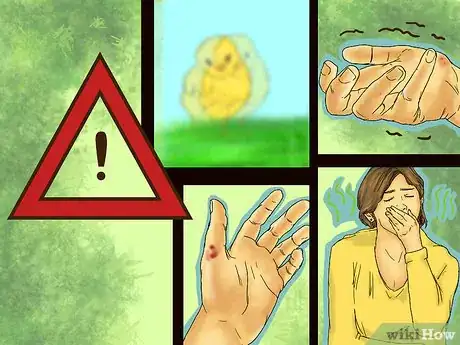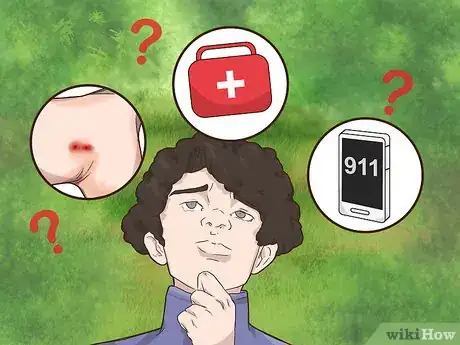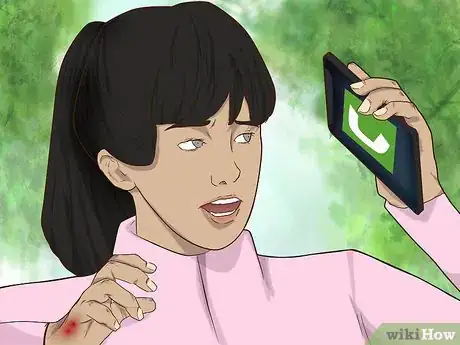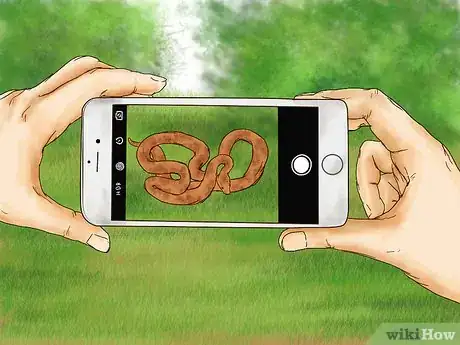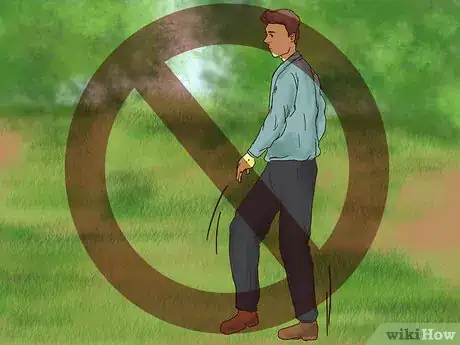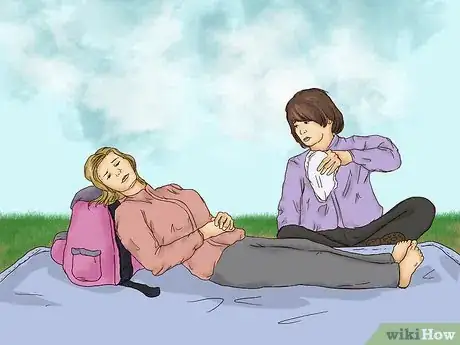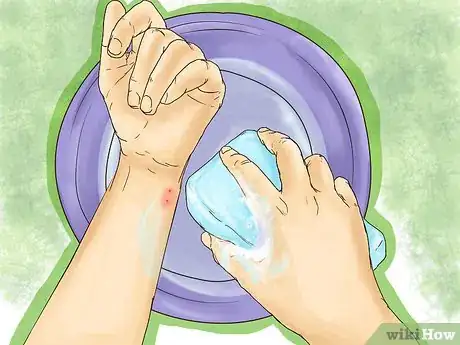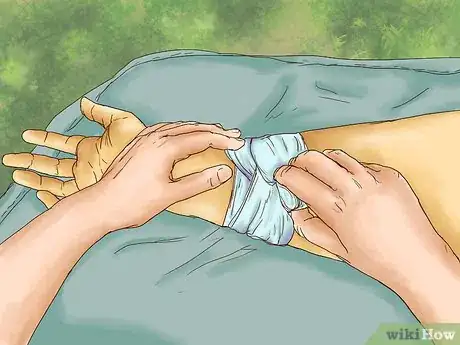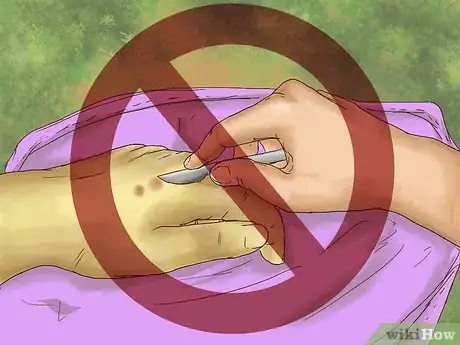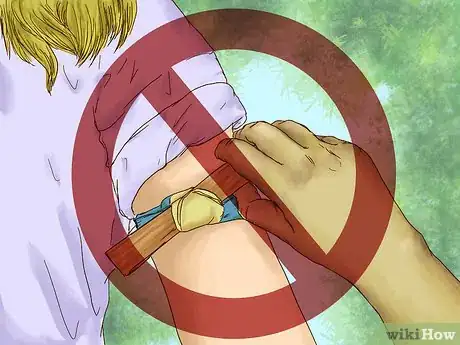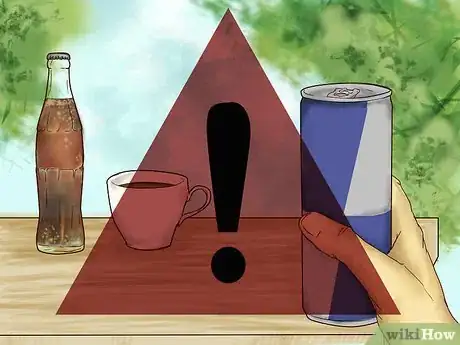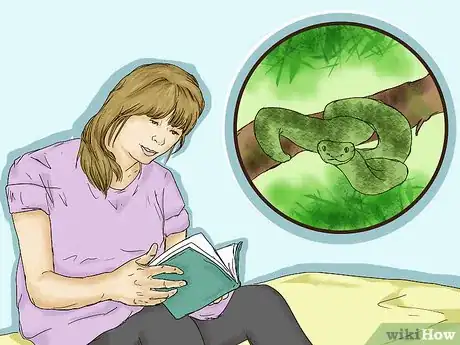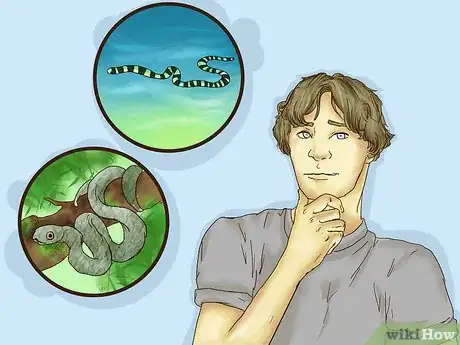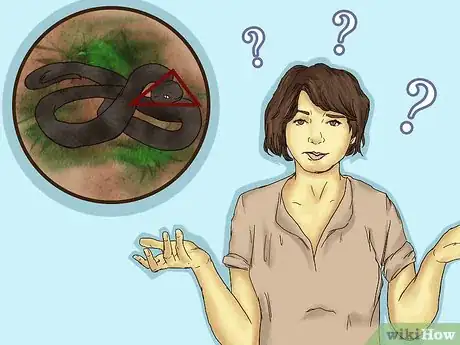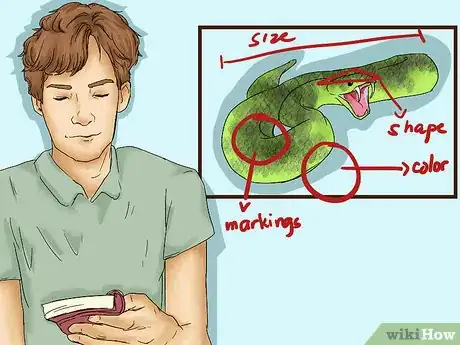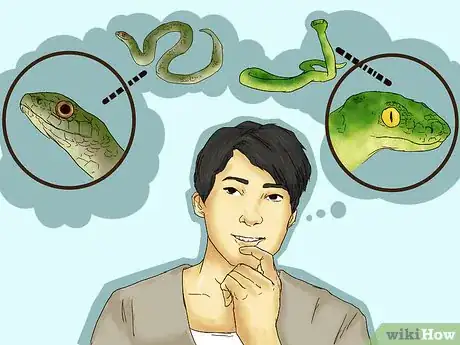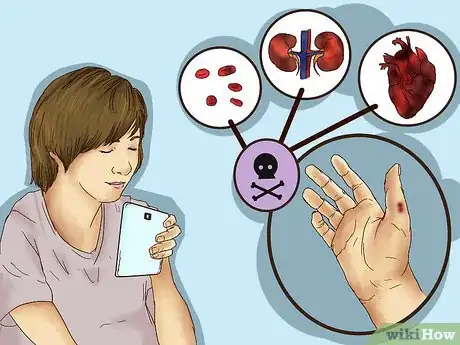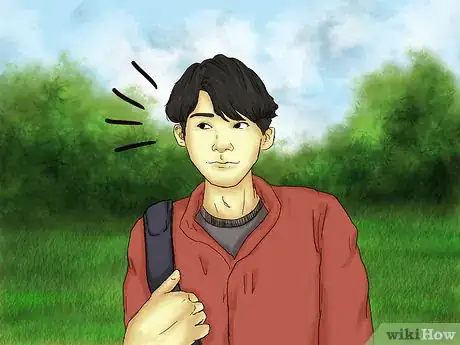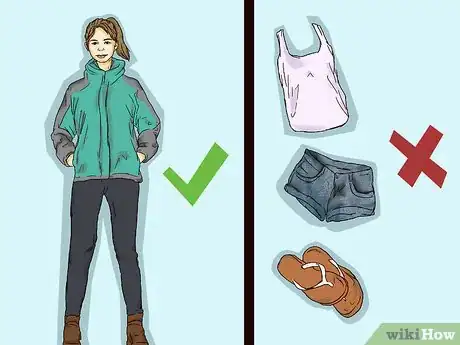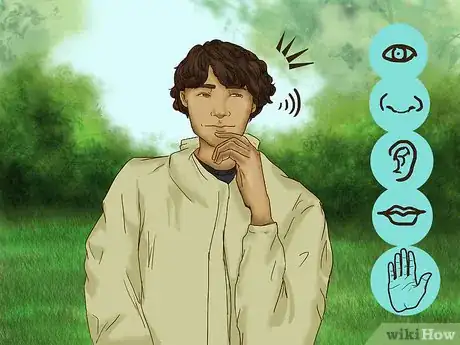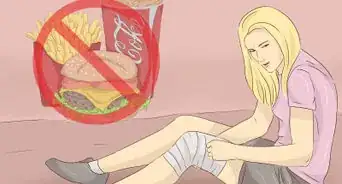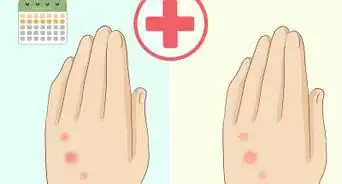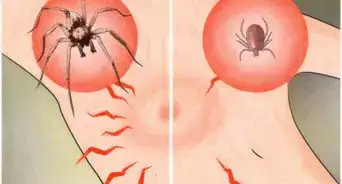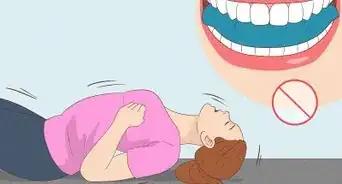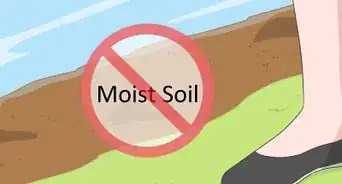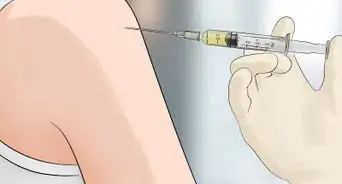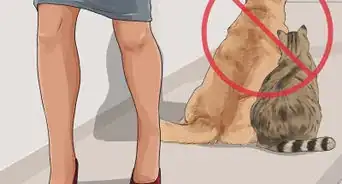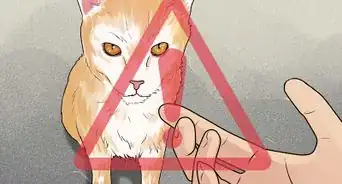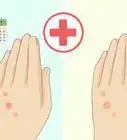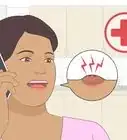This article was medically reviewed by Jonas DeMuro, MD. Dr. DeMuro is a board certified Pediatric Critical Care Surgeon in New York. He received his MD from Stony Brook University School of Medicine in 1996. He completed his fellowship in Surgical Critical Care at North Shore-Long Island Jewish Health System and was a previous American College of Surgeons (ACS) Fellow.
There are 26 references cited in this article, which can be found at the bottom of the page.
wikiHow marks an article as reader-approved once it receives enough positive feedback. In this case, 83% of readers who voted found the article helpful, earning it our reader-approved status.
This article has been viewed 48,839 times.
Despite what we see on T.V., snakes typically don’t bite people unprovoked, and not all snake bites are deadly. If you are bitten by a snake (venomous or non-venomous) while out in the wilderness, what can be an already stressful and fear-inducing experience is complicated significantly by your distance from medical resources. Fortunately, you there are steps that you can take to prevent being bitten, to determine the best route of care for your bite, and to care for yourself appropriately until help arrives.
Steps
Treating a Snake Bite
-
1Determine the type of bite. If you are bitten by a snake in the wilderness, it’s imperative that you have some idea whether the snake that bit you is venomous or non-venomous. If you are injected with venom from the bite, you have one, clear course of action to take: slow the spread of venom while you get help.
- If you are confident that you were bitten by a non-venomous snake, treat the bite site as a puncture wound and clean and wrap it appropriately. Continue to monitor the wound for bacterial infection.
- If you’re unsure about the type of snake that bit you, err on the side of caution by assuming that you’ve been envenomated and proceed accordingly.
-
2Recognize the signs of envenomation. You may not know that you’ve been bitten until you show effects of the venom in your body. It is especially important that you know the signs of having been bitten before you go out in the wilderness. Remember, there are different types of venom and each impact the body differently. Some signs of poisoning include:
- Blurred or disturbed vision
- Swelling or discoloration around the bite, especially redness
- Fang puncture marks (some snakes will only puncture with one of their fangs)
- Tingling or numbness
- Intense pain at the bite site
- Vomiting, nausea, or stomach cramps
- Breathing problems
Advertisement -
3Assess your options. It’s better to leave a snakebite untreated than to treat it improperly. Being bitten by a snake when you’re not close to a hospital can be frightening, and you might panic at first. If you’re bitten by a snake in the wilderness, you need to stop and assess your options so that you can treat yourself appropriately.[1] Do your best to consider:
- Your surroundings. Where are you? Is there a trail or road nearby? Do you recall seeing any signs or landmarks recently?
- Your resources. Do you have a first-aid kit with you? A snakebite kit? If not, what resources do you have? What about a cell phone or two-way radio? If you do have a cell phone with you, make sure to install a first-aid app before you head out.
- Distance from help. When you set off into the wilderness, did you pass a ranger station or medical station? Are you still close enough that you can reasonably get back to a main road and a hospital? If you were to call EMS, how quickly could they reach you? Consider hiking with a PLB (personal locator beacon) if you plan on being out of cellphone coverage.
- Immediate danger. You’ve been bitten by a snake and are in the wilderness, which is dangerous. But look around to consider any other immediate danger such as other snakes, weather, other animals, or life-threatening allergies.
-
4Call for help. The best treatment for a snake bite is that which is given by a medical professionals and first responders. As soon as you realize that you’ve been bitten, seek medical help. Many hospitals in known areas of venomous snakes have ready access to anti-venomous, and the quicker you are injected with an antivenom, the better.[2]
- Don’t wait until pain or swelling becomes too much before calling for help. You risk your own safety, and if you wait too long, it will be too late for the antivenom to be effective.[3]
- When you call for help, give the emergency operator your best location, either as a mile marker or landmark.
- Emergency operators are trained to provide pre-arrival instructions, which you should follow exactly, until help arrives.
-
5Take pictures. If you can, take a picture of the snake that bit you, or at least get a look (if it’s safe to do so) at the snake so that you can describe it to emergency personnel. If, for example, you know that you were bitten by a Coral snake or can describe a snake with red on yellow, that description will help doctors decide what course of treatment is best.
- It is suggested that you circle the bite location with a pen and note the time that you were bitten so that doctors can track the progress of the venom through your body, once help arrives.
-
6Don’t move unless you have to. You need to make sure that you’re out of immediate danger, though you may need to go through your pack to retrieve any necessary supplies (if you are with someone, have them go through your pack instead). Once you are out of harms way and have anything you need from your pack. Venom is circulated through the blood, and the more you move, the higher your heart rate. The more your heart beats, the more your blood is circulated. Move as little as possible until help arrives.
- Remove (or ask another person to remove) any jewelry or tight clothing quickly. These tight items must be removed because you might swell at the bite location, and your jewelry or tight clothing may not be able to accommodate that swelling.
-
7Immobilize the bite. Once you realize that you’ve been bitten (and sometimes people don’t realize it until they exhibit symptoms), immobilize the bitten body part. You want to avoid moving around, and you need to keep the bite location immobilized and below your heart. If you’re out in the wilderness alone and you don’t have a way to contact medical help, you may need to hike for help. Do your best to immobilize the bitten appendage and keep your heart rate down.
- The best case scenario would be to lie down, keeping your head elevated above your heart, and the bite below your heart, which will slow the spread of venom in your bloodstream.
-
8Wash the bite. If you have immediate access to soap and water, wash the bitten area. Your goal is to remove as much of the snake's saliva and venom as possible from your skin. Most snakebite kits will contain materials to wash your skin, also.
- Your goal is to wash the skin. Don’t attempt to flush the bite area with water or any other liquid.[4]
-
9Dress the wound. You need to protect the wound from bacteria after washing the bite site. You should have a kit with you in the wilderness that contains the supplies necessary to bandage your wound. If you are more than half an hour from medical assistance, you’ll need to apply a pressure immobilization bandage.[5]
- Pressure immobilization bandages are bandages that are firmly wrapped around the entire extremity that was bitten. Be sure that you don’t wrap your immobilization bandage too tight. The purpose of this wrapping is to keep your appendage from moving while the pressure slows the spread of the venom.[6]
Avoiding Anecdotal Remedies
-
1Don’t cut around the bite. At one time, some thought that they could cut around a snakebite and remove any venom from the body. We now know that just isn’t true. This is not only ineffective (the venom travels throughout the body via the blood, not the skin), but also leads to loss of tissue and substantially increases the potential for infection.[7]
- Along these lines, don’t ever apply ice or an ice pack to a snakebite. This won’t slow the spread of venom, can lead to tissue damage, and ultimately, can make the injury substantially worse.
-
2Don’t suck try to suck out the venom. It used to be that doctors advised bite victims to try and suck out the venom from the bite wound. Multiple studies show that suction does remove a small amount of venom, but not enough to be helpful or effective. Rather than try suction, just wash, immobilize, and bandage the wound while waiting for help.[8]
- Many snakebite kits still have suction devices in them, but experts agree that they shouldn’t be used.
-
3Don’t tourniquet the bite. If you’re in the wilderness and bitten by a snake, you might recall advice that directed bite victims to tourniquet the wound so that venom wouldn’t spread throughout the body. Multiple studies have shown that this is not only ineffective at stopping or slowing the spread of venom, but also puts the victim at risk of localized tissue damage, or, worse, loss of limb from lack of circulation.[9]
-
4Watch what you drink. Don’t drink anything caffeinated, as this will elevate your heart rate and speed up the spread of the venom throughout your body. Similarly, don’t drink any alcohol as a pain reliever as this will thin your blood and speed up the spread of the venom throughout your body (so will aspirin).[10] Additionally, you don’t want to ingest anything that will contraindicate with any treatments medical personnel administer to you. Your best, safest choice is to drink water and take no pain relievers.[11]
Determining if a Snake is Venomous
-
1Familiarize yourself with local snakes. Learn which snakes live in the region in which you’ll be in the wilderness to help with quicker identification. For example, all venomous snakes in North America (except Coral snakes) are pit vipers. That’s helpful because they all have big, fat bodies, their pupils are oblong, their fangs lay flat in their mouth, and they have heat-sensing pits below their eyes.[12]
-
2Be aware of local snakes' typical environments. Knowing some general guidelines about how snakes hunt, react, where they prefer to live, and how they defend themselves will help you stay out of trouble when you’re in the wilderness.
- Vipers hibernate in the cold and typically mate in the spring and fall, when the weather is warm. Vipers live in all types of climates and can be terrestrial, arboreal, or even aquatic (Water Moccasins).
- Elapidae snakes are typically elusive and are proficient burrowers. This family of snake usually spends their time underground, except during breeding season or rain. There are some Elapidae, however, that primarily live up in the trees or lurk in fallen leaves.
- Sea snakes live in warmer waters, but still come to the surface for air because they lack gills (which makes them easy to distinguish from eels).
-
3Don’t rely on seeing a triangular head. Trying to identify a venomous snake by a triangular head shape has proven ineffective as most snakes have an approximately triangular head shape.[13] Also, the triangular head rule really only works with vipers.
- Many types of animals use camouflage to protect themselves and snakes are no exception. Some non-venomous snakes can even make their head shape more triangular when threatened, mimicking their venomous pit viper cousins.
-
4Take note of markings or coloring. Familiarizing yourself with general traits in coloring, size, and markings can help you quickly identify a snake or its family. Remember, some non-venomous snakes have grown to mimic their venomous cousins as a means of camouflage and protection.
- Vipers have a triangular head, which is wider than the neck. These snakes are often described as a bit fat. Vipers also have long fangs for deep penetration.
- The Elapids have heads that are covered in relatively large scales and their heads are about the same width as their necks.
- Sea snakes have flattened tails (to help them swim) and small heads.
-
5Notice whether the snake’s pupils are round or straight. You may have heard before that venomous snakes have elliptical pupils while non-venomous snakes have round pupils. This rule of thumb is useful for one of the snake families, should you get close enough to see the snake’s eyes.
- Snakes in the Viper family have elliptical pupils, which distinguishes them from similarly marked or colored snakes with round pupils.[14]
- The Elapid and Hydrophidae, or Sea snake, families both have round pupils.
-
6Be aware of the different effects of venom. Not all snakes are the same, and neither are all snake bites. Some bites can be fatal, whereas others may do little more than sting. If you know what family of snake has bitten you, you can appropriately treat yourself if you’re bitten in the wilderness and cannot immediately seek medical attention.
- Viper venom can contain a variety of toxins: necrotizing, causing death of tissue near the bite; anti coagulating, which prevents the blood from clotting, and hemotoxic, causing a very painful bite, and blood issues, such as anemia and, rarely, kidney failure.[15]
- Elapidae venom contains neurotoxins, or nerve toxins, of which there are several varieties, such as presynaptic and dendrotoxins.[16]
- Hydrophidae venom is neurotoxic and myotoxic, which can cause muscle pain, or the other extreme, renal failure and cardiac arrest.[17]
Preventing Snakebites
-
1Be aware of your surroundings. Land snakes like protection and live in the trees, logs, rocky areas, large branches, dead leaves, tall grass, and some burrow underground. If possible, avoid these areas when you’re out in the wilderness.[18] Remember, too, that snakes are wild animals and are unpredictable — you might find one in the middle of a trail or inside your tent, so always pay attention when you’re out in the wilderness.
-
2Wear the right clothes. Because you’re in the wilderness, it’s especially important that you dress appropriately. Don’t go walking or hiking in shorts or sandals. You need to wear long, loose pants at all times to minimize your exposed skin, as well as keep your ankles and legs protected. You should also wear heavy boots or snake boots, so that your feet are protected from any fangs that might try to sink in them.[19]
-
3Don’t touch a dead snake. When you’re out in the wilderness and come across a dead animal, such as a dead snake, you might be tempted to get a closer look. Whether it’s a simple curiosity or because you want to identify the snakes in the area, don’t, under any circumstances, touch the dead snake. Snakes retain reflexes after their death and are able to strike, bite, and inject fatal doses of venom hours after they have died.[20]
- There should really be no reason for you to approach a dead snake in the wilderness; however, if you do, take necessary precautions and stay a good distance away from the animal.
- Touch the snake with a long stick if necessary, so that any post-mortem reflexive biting will be targeted on the stick and not your hand or foot.
-
4Use your senses. Pay extra attention to what your senses are telling you in the wilderness, specifically what you hear, see, and smell. When threatened or trapped, snakes will often utilize defense mechanisms as a warning. You might hear a snake’s rattle or hiss, or smell their defensive secretions, or see a snake with its head raised above its body, for example.[21]
- Many varieties of snakes will hiss to alert you that they see you and are uncomfortable with your presence and is meant as a warning sound to other animals, since snakes don’t have ears.
- The well-known rattle of a snake’s tail is distinctive to the Pit Viper family (rattlesnakes) and this warning should be taken very seriously. If you’re traveling to the wilderness, make sure to listen to several audio clips[22] of actual rattlesnake rattles so that you can immediately identify the sound if necessary.[23]
- Some snakes emit a smell as a warning to other animals, although there is debate as to whether this is exclusive to venomous snakes. What can be agreed upon is that venomous snakes typically emit a defensive smell: some give off sickeningly sweet, sometimes putrid, odor and others emit the smell of cucumbers or melons.[24]
- Even the more aggressive species of snakes will usually avoid a confrontation if given the chance to flee. A bite is usually a last resort for a snake and will be preceded by warnings, such as sounds and smells.
-
5Secure your belongings. The last thing you want is to put your boots on and find a venomous snake still curled up inside, keeping warm. The best way to avoid a snake getting in any of your gear (backpack, tent, food, clothes) is to secure your items. If you have a vehicle with you, lock everything that you can inside. If you only have a tent, secure everything inside your tent so that no snakes make their way inside. Remember if you’re out in the wilderness, you will likely light a fire at some point.
- Even a small fire will give off residual heat long after the flames have died out, and that residual heat, especially if you surround your fire with rocks, will attract snakes.[25]
-
6Use a stick. Snakes don’t have ears, and instead rely on their eyes, tongues, and their ability to feel vibrations. When walking in the wilderness, poke the ground in front of you with a long stick. Doing this will allow snakes to feel your approach before they see you, and that gives them time to get away rather than feel trapped and defensive. Also, if your stick gets too close to a venomous snake and they do attack, they are more likely to attack the stick than you, as that will be the closest threatening object to them.[26]
- Poking the ground with a stick is especially important when you’re walking through tall grass.
-
7Remember your buddies, dogs, and children. Never go out into the wilderness alone. Stick with at least one buddy, just in case one of you is bitten and needs medical assistance. Also, if you set out into the wilderness with dogs or children, make sure to keep them close to you and behind your walking stick if you can. You don’t want to run the risk of them running ahead and encountering a venomous snake.[27]
-
8Freeze and move away slowly. If you do encounter a snake (or smell or hear one), stop moving immediately and consider your options. Ceasing your movements will lessen the immediate threat that the snake might feel. When you can, back away from the snake very slowly. Don’t make sudden movements, and use that long stick as a buffer between you and the snake. Remember, if they’re going to attack, they’re more likely to attack the closest threatening object.[28]
Warnings
- This is only a guide and not guaranteed to work.⧼thumbs_response⧽
- Seek medical attention immediately if you are bitten by a snake.⧼thumbs_response⧽
- Always follow the advice of medical personnel and emergency responders.⧼thumbs_response⧽
- Children are at higher risk of injury from a snake bite due to their smaller size.[29]⧼thumbs_response⧽
References
- ↑ http://theconversation.com/explainer-what-should-you-do-if-youre-bitten-by-a-snake-34238
- ↑ http://www.herpetology.com/bites.html
- ↑ http://arachnophiliac.com/burrow/snakebite_advice.htm
- ↑ http://www.mayoclinic.org/first-aid/first-aid-snake-bites/basics/art-20056681
- ↑ http://emergency.cdc.gov/disasters/snakebite.asp
- ↑ http://circ.ahajournals.org/content/122/18_suppl_3/S934.full
- ↑ https://www.ces.ncsu.edu/gaston/Pests/reptiles/snakebitetx.htm
- ↑ http://circ.ahajournals.org/content/122/18_suppl_3/S934.full
- ↑ https://www.ces.ncsu.edu/gaston/Pests/reptiles/snakebitetx.htm
- ↑ http://www.mayoclinic.org/first-aid/first-aid-snake-bites/basics/art-20056681
- ↑ http://emergency.cdc.gov/disasters/snakebite.asp
- ↑ http://www.wildlife-removal.com/snakepoisonous.html
- ↑ http://www.livingalongsidewildlife.com/2014/05/a-triangular-shaped-head-does-not-mean.html
- ↑ http://www.ncbi.nlm.nih.gov/pmc/articles/PMC2700615/
- ↑ http://snakebiteassist.co.za/venoms/haemotoxic-venom/
- ↑ http://www.toxinology.com/fusebox.cfm?staticaction=snakes/ns-venmed02.htm
- ↑ / http://www.ncbi.nlm.nih.gov/pmc/articles/PMC2700615/
- ↑ http://www.artofmanliness.com/2008/07/15/complete-guide-to-snakes-part-2/
- ↑ http://www.aafp.org/afp/2002/0401/p1377.html
- ↑ http://www.livescience.com/47626-severed-snake-head-can-still-bite.html
- ↑ http://www.peteducation.com/article.cfm?c=17+1831&aid=1648
- ↑ http://www.californiaherps.com/snakes/pages/rattlesnakesounds.html
- ↑ http://www.livescience.com/43683-rattlesnake.html
- ↑ http://nationalzoo.si.edu/animals/reptilesamphibians/facts/factsheets/northerncopperhead.cfm
- ↑ http://www.wta.org/signpost/how-to-hike-in-rattlesnake-country
- ↑ http://www.wta.org/signpost/how-to-hike-in-rattlesnake-country
- ↑ http://www.wta.org/signpost/how-to-hike-in-rattlesnake-country
- ↑ http://www.wta.org/signpost/how-to-hike-in-rattlesnake-country
- ↑ https://www.nlm.nih.gov/medlineplus/ency/article/000031.htm
About This Article
To treat a snake bite in the wilderness, call for medical help right away if the snake was venomous or if you’re unsure whether it was venomous or not. Then, while you wait for help to arrive, lay down with your head propped up and the bite wound below your heart, which will slow the spread of venom through your body. Don’t try to suck the venom out of the wound or use a tourniquet on the bite area, as these remedies can actually cause more harm than good. Instead, just stay as still as possible and wait for help to arrive. To learn how to prevent snake bites, read more from our Medical co-author.

